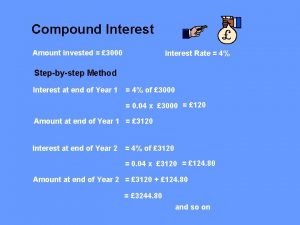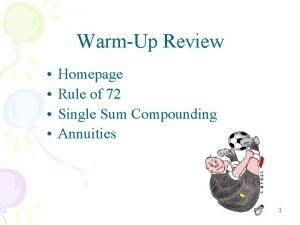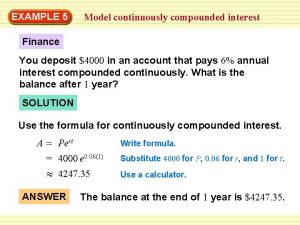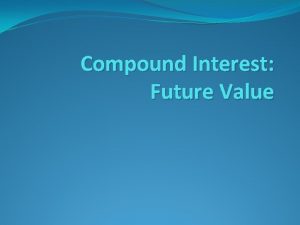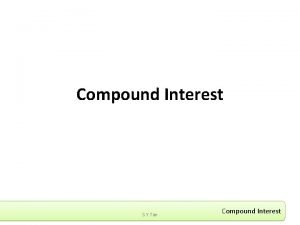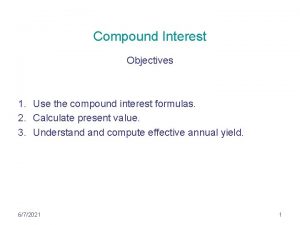Compound Interest I Compound Interest A P 1







- Slides: 7

Compound Interest I. . Compound Interest: A = P ( 1 + r/n)nt A = Account balance after time has passed. P = Principal: $ you put in the bank. r = interest rate (written as a decimal). n = number of times a year the interest is compounded. (annual = 1, semi-annual = 2, quarterly = 4, monthly = 12, etc. ) t = time (in years) the money is in the bank. A) To determine the Account balance after time has passed, plug all the #s into the formula and simplify.

Compound Interest Examples: 1) If you deposit $4000 in an account that pays 2. 92% interest semi-annually, what is the balance after 5 years? How much did the account earn in interest? A = P ( 1 + r/n )nt A = 4000 ( 1 +. 0292/2 )2 • 5 A = 4000 ( 1 +. 0146 ) 10 A = 4000 (1. 0146)10 A = $ 4623. 90 So the account gained $623. 90 dollars in the 5 years.

Compound Interest Examples: 2) If you deposit $12, 500 in an account that pays 4. 5% interest quarterly, what is the balance after 8 years? How much did the account earn in interest? A = P ( 1 + r/n )nt A = 12500 ( 1 +. 045/4 )4 • 8 A = 12500 ( 1 +. 01125 ) 32 A = 12500 (1. 01125)32 A = $ 17, 880. 64 So the account gained $5380. 64 dollars in the 8 years.

Compound Interest II. . Solving for P in Compound Interest: A = P (1 + r/n)nt A) Plug all the #s into the formula. B) Simplify the ( )nt part. C) Divide both sides by the ( )nt part.

Compound Interest Examples: 3) How much would you have to deposit in a savings CD paying 4. 9% annually so that you will have $60, 000 in your account after 12 years? A = P ( 1 + r/n )nt 60, 000 = P ( 1 +. 049/1 )1 • 12 60, 000 = P ( 1 +. 049 ) 12 60, 000 = P (1. 049)12 (1. 049)12 P = $ 33, 795. 20

Compound Interest III. . Solving for r in Compound Interest: A = P (1 + r/n)nt A) Plug all the #s into the formula. B) Divide by the P part to get (1 + r/n)nt by itself. C) Get rid of the exponent with a radical. 1) Use a reciprocal fractional exponent. D) Evaluate the A/P^(1/nt) term with a calculator. E) Solve for r. 1) Move the decimal 2 places to get a %.

Compound Interest Examples: 4) Your Great Grandpa bought his bride to be an engagement ring valued at $200. 00 back in 1928. It was appraised in 2008 as being worth $12, 500. What was the rate of increase per year? A = P ( 1 + r/n )nt 12500 = 200 ( 1 + r/1 )1 • 80 12500 = 200 ( 1 + r )80 200 62. 5 = (1 + r )80 62. 5^(1/80) = ( 1 + r )80 • (1/80) 1. 053 = 1 + r (subtract the 1). 053 = r so r = 5. 3%



